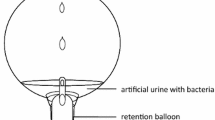Abstract
Encrustation and blockage of indwelling urethral catheters is primarily brought about by infection of the urinary tract by Proteus mirabilis or other urease-producing species. The bacteria colonise the catheter forming a biofilm community within a polysaccharide matrix. The activity of the urease drives up the urinary pH and causes the crystallisation of calcium and magnesium phosphates in the biofilm. We have used a simple physical model of the catheterised bladder to investigate the ability of urease inhibitors to control encrustation. It was observed that acetohydroxamic acid (1.0 mg/ml) and fluorofamide (1.0 μg/ml) restricted the increase in pH of P. mirabilis-infected urine from 9.1 to 7.6. Significant reductions in the deposition of calcium and magnesium salts were also recorded on the silicone catheters. Electron microscopy confirmed that encrustation and occlusion of the catheter lumen was minimal in the presence of the urease inhibitors. The data from this in vitro study suggests that urease inhibitors, particularly fluorofamide, could have clinical applications in the prevention of catheter encrustation and blockage.
Similar content being viewed by others
Author information
Authors and Affiliations
Additional information
Received: 22 September 1997 / Accepted: 2 January 1998
Rights and permissions
About this article
Cite this article
Morris, N., Stickler, D. The effect of urease inhibitors on the encrustation of urethral catheters. Urological Research 26, 275–279 (1998). https://doi.org/10.1007/s002400050057
Issue Date:
DOI: https://doi.org/10.1007/s002400050057




